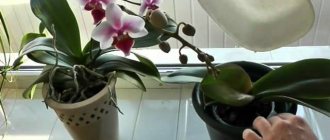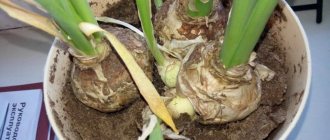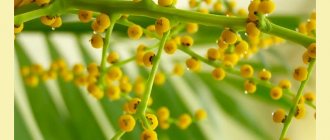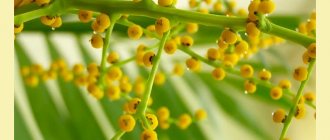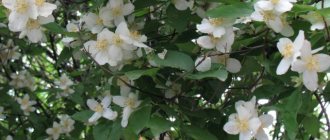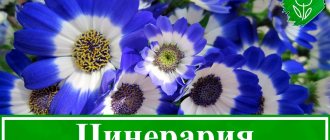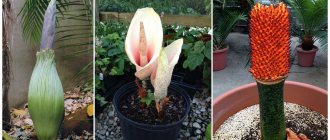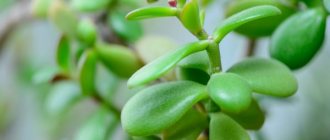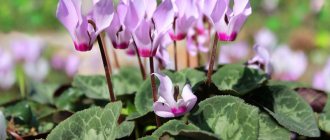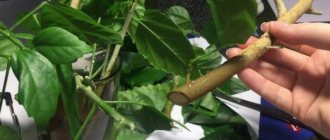The bulbous flowering perennial plant hyacinth (Hyacinthus) is a member of the Asparagus family, but previously it was part of the Liliaceae family, and it was also classified as a separate Hyacinth family. Translated from ancient Greek, hyacinth means “flower of rain.” The plant was named after the hero of the ancient Greek myth. In those ancient times, there lived a very handsome young man Hyacinth, the son of the king of Sparta. His friend was the god Apollo; he often descended from heaven to earth to teach Hyacinth to throw discs. And then one day, while training Hyacinth, Apollo threw a discus, and the young man rushed after it to return it to the god. However, the god of the West Wind, who was secretly in love with the prince, became jealous of him, and was able to turn the disk in such a way that he broke the handsome man’s head. Hyacinth was dying in his friend's arms, and he could do nothing to save him. Then God, heartbroken, decided to create an incredibly beautiful flower from drops of the blood of a beautiful young man, which was called hyacinth.
Brief description of cultivation
- Landing . Hyacinth bulbs are planted in the fall in September or October. And they are dug up every year after the foliage turns yellow (in the last days of June or early July).
- Storage . For storage, the bulbs are placed in a well-ventilated area with moderate humidity. They are placed in paper bags or in 2 layers in boxes. For the first two months, planting material is stored at a temperature of about 25 degrees, and then it is transferred to a cooler place (about 17 degrees).
- Illumination . Needs plenty of bright sunlight.
- Soil . It should be nutritious, drain well and contain a large amount of humus. Acidity should not be lower than 6.5.
- Watering . During prolonged drought, hyacinths should be watered so that the soil is wet to a depth of 15 to 20 centimeters.
- Fertilizer . You need to feed the flower twice or three times during the season. The first feeding is at the very beginning of the growing season with phosphorus-nitrogen fertilizer, the second is during the formation of buds and the third is when the bush fades with phosphorus-potassium fertilizer.
- Reproduction . Seeds and babies.
- Harmful insects . Flower flies (hoverflies), aphids, thrips, onion root mites, stem and root-knot nematodes and mole crickets.
- Diseases . Penicillium rot, rhizoctonia blight, fusarium blight, yellow or soft bacterial rot, variegation.
- Properties . Any part of the plant contains a poisonous alkaloid.
Hyacinth diseases
Leaves, inflorescences and bulbs are subject to various diseases:
- fungal;
- bacterial;
- viral.
The most common diseases:
- blossom end rot - caused by soil pathogens;
- gray mold;
- wet rot;
- bulb rot - penicillosis of bulbs;
- hyacinth mosaic.
Plant bulbs are stored in a cool, dry place. Particular attention should be paid to bulbs with small round yellow spots under the husk or light brown spots blending into larger spots. The former probably means infection of the bulb with gray mold, the latter - dry rot. It is better to throw them away because by putting them back in the ground we will infect other hyacinths with both fungal diseases. Bulbs should always be treated with a fungicide before planting.
Features of hyacinth
Hyacinth is one of the earliest spring flowers. This plant is native to North Africa, the Middle East and the Mediterranean. However, Holland has done a lot to popularize hyacinth, which is why many people call it the world’s “hyacinth center.” The largest number of varieties and varieties of hyacinth appeared in the Netherlands. And from the city of Haarlem, which is located in Holland, a huge number of bulbs of this flower are sent all over the world every year.
In hyacinths, the dense bulb consists of lower succulent leaf plates. The height of the flowering stem is about 0.3 meters; it is a continuation of the bottom. In a faded bush, the stem dries out along with the narrow leaf plates directed upward, which sit at the very bottom of the stem. However, in the corner of the upper leaf plate on the stem inside the bulb, a bud is formed, which over time becomes a new bulb, which will bloom next year. Bulbs can also form in the corners of other leaf blades, but they are weaker. These bulbs are children; if necessary, they can be separated and new bushes grown from them. The flowers are part of the apical racemes, which have a cone-shaped or cylindrical shape. The flower's perianth has the shape of a bell-shaped funnel, its blades are bent, and the color is rich. The inflorescences can be painted in various color shades, for example: red, purple, yellowish, white, pink, blue, etc. The flowers can be double or simple. This plant has a three-lobed fruit, with each nest containing a pair of seeds covered with a delicate peel.
All about HYACINTHES: proper planting of hyacinths, care and feeding. Subtleties of forcing hyacinths
When does hyacinth bloom?
It blooms for a long time, from April to May, and is much more abundant than wild plants of this species. Available for sale are white, pink, purple, yellow and red hyacinth flowers.
Gardeners create suitable conditions for them to bloom at the turn of winter and spring.
Features of cultivation
Each crop has its own agrotechnical requirements. Hyacinth differs from many flowers in that it is quite capricious and demanding to care for. That is why, before decorating your garden with it, you need to find out how to properly care for it and what it needs for normal growth and development. Basic rules for growing hyacinth:
- The soil must be neutral; it should contain turf and leaf soil (1:1), as well as baking powder. If the soil is acidic, then lime will have to be added to it, and clayey soil can be corrected by adding sand to it.
- This plant reacts extremely negatively to stagnation of water in the soil, which is why it should be provided with good drainage.
- Choose a sunny place to grow hyacinth, but excessively bright lighting can harm it.
- A site that is located close to trees and shrubs is well suited for planting, because the flowers must be protected from gusts of wind.
- Do not feed hyacinths with fresh organic fertilizer.
Hyacinth – photo
Hyacinth doesn't cause any trouble, but that's not the main reason for its popularity. First of all, this is a very bright, beautiful and spectacular plant. See for yourself!
Photo: wikiterra.ru
Photo: house-studio.ru Photo: pxhere.com Photo: flowersalon.net
Photo: oir.mobi
Photo: vk.com Photo: kartoska.ru
Photo: lakkk.com
Photo: wallbox.ru Photo: gazato.ru Photo: samrukamy.ru Photo: oir.mobi Photo: sady-msk.ru
Photo: flowerglossary.com Photo: ru.best-wallpaper.net Photo: attuale.ru Photo: funart.pro Photo: 1zoom.ru
Photo: botanichka.ru
Photo: goodfon.ru Photo: on-desktop.com
Photo: kartinki-cvetov.ru Photo: oir.mobi
Photo: koffkindom.ru
Photo: floribunda.ru Photo: vk.com Photo: ndpi2.kmr.socinfo.ru
Photo: agrosetka74.ru
Blueberry Patriot: variety description, care and planting
Planting hyacinths in open ground
What time to plant
Hyacinth bulbs are planted in open soil in the last days of September or the first days of October. If you plant them ahead of schedule, then they may begin to grow, and the coming winter cold will destroy them. If they are planted later than necessary, then they may not have time to take root well before frost.
The area where hyacinths will grow must be prepared in advance. Digging the soil to a depth of 0.3 to 0.4 m, add 10 to 15 kilograms of rotted compost or three to four year old humus, as well as approximately 15 grams of magnesium sulfate, 70 grams of superphosphate and 30 grams of potassium sulfate from calculation per 1 square meter. Depending on what the soil consists of, you can also add peat or sand to it if necessary. If the soil on the site is sandy, then 1.5 times more potassium and magnesium fertilizers should be added to it. It is recommended to feed hyacinths with nitrogen-containing fertilizers in the spring and summer.
Planting in autumn
It was already mentioned above that hyacinth bulbs are planted in the garden in the autumn, or more precisely, in September–October. Experienced gardeners advise planting medium-sized bulbs, which are also called “flower bulbs,” because they produce flower stalks that are highly resistant to bad weather.
First, inspect the planting material and remove all diseased, soft or injured bulbs. Then, before planting in the soil, they are immersed in a solution of a fungicidal preparation for 30 minutes. The bulbs, reaching approximately 50 mm in diameter, are planted to a depth from the bottom of 15 to 18 centimeters, the row spacing should be about 20 centimeters, and the distance between the bulbs should be 15 centimeters. Smaller bulbs, as well as children, are planted at a shallower depth, and the distance between them also needs to be reduced.
Hyacinth grows best in open soil if it is planted in a “sandy jacket”. To do this, a layer of clean river sand is poured onto the bottom of the groove or planting hole, the thickness of which should be about 30–50 mm. Press the onion a little into this layer and sprinkle it on top with sand and only then with soil. Thanks to this planting method, there will be no stagnation of water in the soil, as a result of which the risk of rot on the bulb will be significantly reduced. If the bulbs are planted in dry soil, they must be watered.
Planting hyacinths in a new way
Spring planting
Hyacinth bulbs are not planted in spring.
Features of planting and care in pots
Hyacinths grow equally well in garden beds and in home pots. You can enjoy the wonderful scent and colors of the flowers on your terrace or even at home. The planting period for pots is the same as in the garden - October-November. The substrate must be fertile, then fertilizing is not needed. Composted soil mixed with sand is used successfully. A drainage layer is placed at the bottom of the pots to drain excess water.
The bulbs are planted in a pot or container so that they do not touch each other. The planting depth is equal to twice the diameter of the bulb. To ensure that the soil adheres well to the bulbs, it is lightly watered. The pots are then placed in a cool, dark room for 10 weeks. During this period, the plants are watered very moderately.
Caring for young plants. When shoots begin to emerge from the ground, the flowers must be exposed to light. The pots are placed on the windowsills, saturating the plants with the warmth of the sun's rays through the glass. The larger the plant gets, the more water it needs. That is, the substrate should be constantly damp, but not wet. To retain moisture, moss is placed on the ground, which decorates the pot in an interesting way. The heavier inflorescences are tied to supports.
Hyacinth care
Caring for hyacinth grown in open ground is not too difficult, but you need to know all the agrotechnical rules of the crop and be sure to follow them. First of all, you need to ensure that there are no weeds in the area where the hyacinth grows, so weeding should be regular and timely. You should also remember that the surface of the soil around the bushes must be systematically loosened and this is done quite often. In order to reduce the number of watering, weeding and loosening after planting the bulbs in the ground, its surface is covered with a layer of mulch. Hyacinth should be watered only during drought, and the soil must be wet to a depth of 15–20 centimeters.
Fertilizer
In order for such flowers to grow and develop well, they must be fed in a timely manner. During the growing season, you only need to feed the bushes 2 or 3 times. Flowers can be fed with dry fertilizer, applied to the soil, or with a liquid nutrient solution (in this case, slightly less fertilizer is used). Before adding a nutrient solution to the soil, the flowers must be watered. If dry fertilizers are used, then they are scattered over the surface of the site, and then embedded in the ground using a hoe. Feeding time:
- the first - at the very beginning of the growing season, 20 to 25 grams of saltpeter and 15-20 grams of superphosphate per 1 square meter are used for fertilizing;
- the second - during the formation of buds, for this purpose 30 to 35 grams of superphosphate and 15–20 grams of potassium sulfate are added to the soil per 1 square meter;
- third - after the bushes have flowered, 30–35 grams of potassium sulfate and the same amount of superphosphates per 1 square meter are used.
Transfer
In order to transplant hyacinths to another area, it does not require much effort. To begin with, in the summer, when the bushes have faded, dig up the bulbs and put them away for storage. And with the onset of autumn, plant them in a new area. The bulbs are dug up a couple of months after the hyacinths have faded. This time is necessary so that the bulbs have time to regain strength after the growing season and flowering.
Watering hyacinths
The soil should be slightly moist during the growing season. When watering, you should try not to wet the top of the plant to avoid fungal growth.
Propagation of hyacinths
Growing from seeds
Hyacinth can be propagated by seed, which is ideal for those involved in plant breeding. Sowing of seeds is carried out in the last days of September, for this they use a box filled with a substrate consisting of humus, leaf soil and sand (2: 1: 1). Seedlings are grown for two years in a cold greenhouse. Hyacinths that emerge from seeds very rarely retain the varietal characteristics of the mother plant, which is why gardeners prefer to propagate such a plant vegetatively.
Reproduction by children
It is much easier to propagate hyacinth by children than by seeds. But at the same time, you need to take into account that the children on the bulbs grow extremely slowly, so in 1 year from 1 to 3 children can be formed. Try to separate the babies from the parent bulb; if they come off without much effort, then they are planted in a separate hole and grown. However, if the children are separated with great difficulty, then they are left on the parent bulb, which is planted in the ground with them.
In industrial floriculture, hyacinths are propagated by artificial methods, namely by cutting and cutting out the bottom. To do this, take a very sharp instrument and sterilize it well, make cuts on the bottom with it, or cut it out completely. Next, the bulbs are stored in a special way, and they form babies. It happens that about 40 children are formed on one bulb. This method of propagating hyacinths is described in great detail in the book “Plant Reproduction” by F. MacMillan Brose.
Propagation of hyacinth, cutting out the bottom, varietal hyacinths
What does hyacinth look like?
The power of hyacinth is contained in the hard bulb, which contains substances beneficial to the plant and hides the bud of the inflorescence. When warm weather comes after winter, sprouts emerge from the center of the rosette. Soon 20-30 cm leaves of pink, purple, blue or white flowers appear. They all smell strong.
Their bulbs are often grown in flower beds, among other spring species. It is worth noting that at the beginning of summer, the above-ground parts of hyacinths die off, and the onion goes into a dormant state, which continues until next spring.
Diseases and pests of hyacinths
Diseases
Hyacinths are quite resistant to diseases. However, if they were affected by the disease, then this could happen for the following reasons:
- the purchased planting material was already affected by the disease;
- the flowers were fed with fresh organic fertilizer;
- bad predecessors;
- a spoiled onion was planted in the ground;
- before planting, the bulbs were not subjected to preventive treatment;
- planting too thick.
Most often, this plant is affected by bacterial rot (bacterial disease), because of which the bulbs become like mucus, which smells very bad. The first signs of rot are that the bush is stunted in growth, and stripes and spots form on its foliage and peduncles. Diseased flowers are removed from the soil and destroyed, and the place where they grew is treated with bleach.
Hyacinth can also be affected by penicillium rot (a fungal disease). All parts of the affected bush located above the ground are covered with plaque, which is a product of sporulation of the fungus, rot appears on the plant, and its flowers dry out. To save the plant, it should be treated with a product containing copper.
Harmful insects
Various pests can also greatly harm hyacinth. The greatest danger to it is posed by flower flies; their larvae gnaw out the bottom of the bulbs. In order to get rid of them, they use such means as: Tabazol, Fly eater or Aktara. The flower can also be damaged by the mole cricket, which eats its underground part, as well as the root onion mite; the best way to combat such pests is by mulching the soil surface around the bushes.
It happens that the inflorescence just appears from the rosette and almost immediately falls out of it. This can happen due to stagnation of water in the ground, due to storing the bulbs in too cold a place, or due to early planting.
Pest and disease control
If the hyacinth does not bloom, most likely it does not have enough sun or the temperature regime has gone wrong. The flower does not like either extreme cold or extreme heat. If it rots or the buds fall off, you have problems with watering and fertilizers. The main reason that leaves turn yellow early is lack of moisture and drafts, and hyacinth withers due to lack of sunny color.
Photo: design-homes.ru
Care after flowering
After the hyacinths fade, their bulbs begin to regain their strength. Therefore, they must remain in the soil for some time. As soon as the bushes begin to fade, all care should be reduced to a gradual reduction in watering until it stops completely. In addition, do not forget to fertilize the soil for the third and last time at this time; thanks to it, the bulbs will receive the necessary amount of nutrients, which will have a beneficial effect on the growth and flowering of hyacinths in the next season. You can tell that the time has come to remove the bulbs from the ground by the foliage, which should turn yellow.
Digging up the bulbs
It is necessary to remove the bulbs from the soil every year. Otherwise, next season the bushes will bloom sparingly, and the likelihood that the bulbs will be affected by disease also increases. Also, thanks to the digging of hyacinths, which is carried out every year, it is possible to promptly discard spoiled bulbs and regularly separate the children.
Try to dig up the bushes before their foliage dies and falls off, as in this case it is very difficult to find the exact location of the bulbs. To remove the bushes from the ground, use a shovel, since the bulbs are located quite deep. The extracted bulbs will need to be washed under running water and pickled for half an hour in a Karbofos solution (3–4%), instead they can be left for 10 minutes. soak in very warm water (about 50 degrees). After this, they are placed in a shaded, well-ventilated place to dry for 7 days, the air temperature should be about 20 degrees.
How to preserve hyacinth after flowering
Storing hyacinth bulbs
At this time, you need to take care of the bulbs with all responsibility, since it is now that the inflorescence will form in them. After the bulbs are dried, they need to remove any remaining scales and roots. After which they are sorted and placed in boxes (preferably in 1 layer). It is better to leave too small children on the bulbs. If there are few bulbs, then to store them you can use paper bags with a signed label attached to them.
During storage of hyacinths, there are 2 stages. During the first two months, the bulbs should be kept at a temperature of 25 to 26 degrees, and then they are removed to a cooler place (about 17 degrees). The air should not be too dry, as this may cause the bulbs to dry out. In order to shorten the first stage of storage by 7 days, in the first week the planting material should be stored at a temperature of about 30 degrees. Do not forget that you need to choose a well-ventilated room for storing hyacinths. And immediately before planting the bulbs in the ground in the fall, it is recommended to keep them for about 7 days at the temperature that is typical for the garden. As a rule, during storage a large number of small children are formed on the bulbs; therefore, they must be planted in the soil very carefully.
Hyacinths at home
The nutrient reserves contained in the bulb allow hyacinths to easily wake up from sleep.
While it's cold outside, people are happy to decorate their apartments with them. An interesting way to grow this plant is in glass so that the roots are visible. Hyacinths in containers can decorate the surroundings of the house and bloom in flower beds.
Types and varieties of hyacinths with photos and names
Hyacinth has been cultivated both in open ground and indoors for about 400 years. And not so long ago, experts believed that there were about 30 species and approximately 500 varieties of hyacinths. However, when the reorganization of classifications in botany occurred, most species were transferred to another genus. Today there are only 3 types of hyacinths, namely: eastern hyacinth (Hyacinthus orientalis), Litvinov hyacinth (Hyacinthus litwinowii) and Transcaspian hyacinth (Hyacinthus transcaspicus). Thanks to the efforts of breeders, many varieties and varieties have been obtained from these species.
All varieties are divided according to the shape of the flower - double and simple, according to the timing of flowering - late, early and middle, and also according to the color of the flowers. In the classification of flower color, all varieties are divided into 6 groups.
Blue hyacinths
- Perle Brillante . This is a late-flowering variety, the flowers have a pale blue hue, the height of the bush is about 25 centimeters, the flowering duration is about 20 days.
- Marie . An early flowering variety, flowering lasts from 16 to 18 days. The flowers are dark blue in color and decorated with a longitudinal purple stripe.
- Queen of the Blues . The flowering of this medium variety lasts approximately 15 days, the height of the bush is about 30 centimeters. The bluish flowers have a faint odor.
Lilac hyacinths
- Blue Magic . The height of the bush of this medium variety is about 25 centimeters, flowering lasts from 10 to 12 days. The color of the flowers is violet-purple.
- Indigo King . This late-flowering variety blooms for about 15 days, the length of the arrow is from 15 to 17 centimeters. The flowers are glossy purple-black.
- Bismarck . The flowering of this early-flowering variety lasts about half a month; the bush reaches a height of 22 to 25 centimeters. Light purple flowers are decorated with a longitudinal stripe of a more saturated shade.
Pink hyacinths
- Moreno . The early-flowering variety blooms for 13–18 days, the peduncle reaches a length of 20 to 23 centimeters. The color of the flowers is raspberry pink, they have a stripe of a darker shade.
- Anna Marie This medium variety has a long arrow - from 20 to 25 centimeters, and its flowering lasts approximately 15-17 days. The flowers are painted in a soft pink shade.
- Gertrude . The flowering period of this late-flowering variety lasts from 13 to 15 days, and its peduncle reaches a height of 23–25 centimeters. The flowers are dark pink.
Red hyacinths
- Hollyhock . This late-flowering variety blooms for 15–18 days, its peduncle has a height of 20–22 centimeters. Double flowers have a crimson-red color.
- La Victoire . The height of the peduncle of this early-blooming variety is from 20 to 25 centimeters, and glossy pinkish-red flowers open on it. Flowering duration is from 11 to 12 days.
- Tubcrgen's Scarlet . The flowering of this average variety lasts a little longer than half a month. The height of the peduncle is about 20–22 centimeters, the flowers are deep red and can be double.
White hyacinths
- Arentine Arendsen . The height of the bush of this early-flowering variety reaches 21–22 centimeters; it blooms from 15 to 18 days. The flowers are white or may have a cream tint.
- Snow Crystal . This late-blooming hyacinth has white, double flowers. Flowering duration is 13–18 days, and stem length is 25–28 centimeters.
- Madame Sophie . The flowering of this medium variety lasts 13–15 days, its stem length is from 19 to 23 centimeters. Double flowers are white.
Yellow and orange hyacinths
- Yellow Hammer . The arrow of this medium variety reaches 23–25 centimeters in length, and it blooms for 13 to 15 days. The flowers, painted in a rich yellow color, fade towards the end of flowering.
- City of Haarlem . The late-flowering variety has a flowering duration of 15 to 17 days, the length of the peduncle is from 25 to 27 centimeters. The yellowish flowers become pale cream at the end of flowering.
- Orange Boven . The flowering of this medium variety lasts about half a month. On peduncles 22–24 centimeters long there are apricot-salmon flowers, the edges of which are dark pink.
Most often, blue varieties begin to bloom first, and then white, pink, red, and lilac. And orange and yellow varieties bloom later than everyone else.
hyacinths 30 varieties
Hyacinth flower
The hyacinth plant has very impressive inflorescences up to 30 cm high, consisting of several dozen bell-shaped flowers that exude an intense, original aroma. These sweet-smelling flowers come in various shades of pink, blue and purple. There are also white and cream varieties.
Photos of hyacinths on the Internet will give you a more detailed idea.
Botanical description
Hyacinth (Hyacinthus) is a perennial bulbous flowering plant from the Asparagus family.
This herbaceous crop is an ephemeroid (a plant with a very short growing season).
It develops, blooms and bears fruit only in spring; in other seasons the growing season stops. After flowering, the stem dries up along with the leaves, and a bud forms on the stem inside the bulb, which then turns into a new bulb.
Hyacinth is a low compact bush. He has:
- A large perennial round bulb with a diameter of 4-6 cm, covered with thin filmy scales. Every year the bulb increases in size due to the formation of new scales; it lives up to 10 years. At 5-6 years of life, daughter bulbs begin to form, which makes it possible to propagate the flower vegetatively.
- The leaves are basal, narrow, grooved, during the flowering period they are small in size, and after the peduncle dies, they grow up to 20 cm. They are dark green in color, dense, directed upwards.
- The peduncle is thick, fleshy, can reach 30 cm in height (depending on the variety it has different lengths). A racemose inflorescence is formed on it, formed by small flowers in the amount of 12 to 35 pieces. Thanks to the large number of flowers, the plant looks curly.
- Bell-shaped flowers are attached to short stalks, their petals are bent from the center. They emit a very rich, pleasant aroma. In nature, the corolla of hyacinth is usually colored blue or white, and the range of varietal flowers is very wide - pink, red, lilac, dark purple, blue, yellow, orange. The riot of colors pleases the eye for about a month.
- The hyacinth fruit is a capsule that consists of 3 nests with seeds.
Varieties
Currently, breeders from different countries have developed about 400 varieties of hyacinth, which differ mainly in the color and shape of the flowers. The Dutch are especially successful in this matter, selling varietal bulbs in the millions.
Below are photos of hyacinth flowers of the most popular varieties:
Woodstock (Woodstock) – lilac-red flowers, a variety of Dutch selection
Carnegie (Carnegie) - snow-white flowers, a variety of Dutch selection
Chicago (Chicago) - large blue-white flowers, variety from the famous Dutch producer Mosselman Holland BV
Royal Navy - large blue flowers with a narrow white stripe along the edge of each petal
Apricot Passion (Apricot Passion) - flowers of soft apricot color
Ailos is one of the most popular varieties. Compact multi-flowered inflorescence in the form of a candle, large white flowers
Hyacinth variety "Fondant" - a rather rare pink color of the petals
Hyacinth Jan Bos (dark) - photo
Another pink hyacinth - Pink Pearl variety
Deft Blue is a very popular variety
Hyacinths in landscape design, photos - examples of flower bed design
Hyacinth flowers are among the most popular garden plants. This is due to the richness of the flowers and ease of cultivation. Planted in groups of the same color, these beautiful flowers create impressive colorful displays in flower beds. They also look good in pots and wicker baskets.
Photo. Flower beds and flower beds with hyacinths
When planning a large flower bed, it is worth planting hyacinths in groups - several, a dozen or so bulbs of the same variety. Flowers will create spectacular, colorful islands.
By choosing flowering varieties at the same time, you can achieve the effect of a patterned carpet or scarf.
Hyacinth is a wonderful decoration for any garden, summer cottage, or small flower bed. The plant is easy to grow, planting the bulbs does not involve any special measures, caring for the shoots is simple, regular watering is required, especially during periods of drought. These extremely beautiful plants are probably a favorite in the spring, producing extremely gorgeous blooms that are intensely colored and fragrant. It's no wonder that many people want to grow this charming bulbous plant in the garden or in pots at home.
What to do with purchased blooming hyacinth?
Sometimes amateur flower growers do not have the opportunity to grow hyacinths in a garden or flower bed. In another case, a spontaneous purchase of a potted hyacinth in a supermarket in early spring obliges you to continue caring for and growing the plant at home. There is nothing wrong with this: hyacinths calmly survive and bloom even in artificially collected conditions. We give you some tips to help you choose suitable conditions for cultivating hyacinths at home.
Transfer
Do not forget that hyacinth is primarily a garden plant, although it can be grown very successfully at home. It is better to transplant the hyacinth into another pot after the store immediately after flowering. You can place up to three bulbs in one pot. Avoid contact of the bulbs with each other and with the walls of the pot - it is better to take a larger container. We pour drainage (expanded clay, sand), then soil for flowering plants. It is better if it is mixed with peat: this way you will save yourself from unnecessary feeding, and it will be easier for the plant to adapt. After the above-ground part dies, watering is reduced and the pot is placed in a dark place.
Home cultivation
In order for hyacinths to delight you with regular flowering and a healthy appearance, we recommend observing several conditions for growing at home:
- The soil . The composition must be optimal, the substrate must contain a mixture of earth, sand, peat or humus;
- Place of cultivation. The best option would be to place it on south and south-east windows;
- Lighting . Daylight is required - daylight hours of at least 15 hours in duration. If the windows are north or west, you need to illuminate them with a lamp. However, direct sunlight should be avoided;
- Temperature . Comfortable growth of hyacinth is observed at 20-22 degrees Celsius. When forcing, you need to reduce it to 15 degrees (“spring”);
- Watering . Regular, only on the soil, no need to pour water on the leaves and stem to avoid rotting;
- Feeding . Fertilizers are constantly needed, since hyacinth produces them from the soil very intensively. You can use any universal flower fertilizer.
Reproduction
Dilution of hyacinth occurs extremely slowly. Basically, to speed up the reproduction process, they resort to stimulating the bulbs in the following ways:
- Cutting out the bottom. Large bulbs are dug up, washed and dried. After 7 days, the roots begin to fall off, then a wedge cut is made with a sharp knife, the bottom and the bud are removed. Afterwards, the planting material is placed cut side up in a container, sprinkled with coal and covered with a bag. After 3 months, the rudiments of roots and sprouts appear.
- Scales. The bulb is divided into 4 parts and the scales are broken off from below. Place in a bag of sand. They keep it for a month and a half at +22 degrees and the same amount at +18.
- Notching the bottom. An incision is made at the bottom in the shape of a cross, sprinkled with coal and left in a warm room. As a result, 15 new bulbs appear.
- Cuttings. It is carried out when there is a bud on the flower. Take two leaves at the very base and plant them in a medium container with 4 cm of coarse sand. It is placed in a durable plastic bag and kept warm at high humidity.
History of the origin of hyacinth
There are many stories associated with the origin of hyacinth. The most popular one says that the flower was reborn from the blood of the son of the Spartan king, who, by an absurd accident, died at the hands of Apollo during a sports competition. In honor of which he received his name.
In Greece it symbolizes death, sadness and, at the same time, joy and love.
When the plague was raging in Athens, on the orders of Apollo, the five daughters of the wanderer Hyacinth were sacrificed to the Cyclops Hephaestus. And young Greek girls wove flowers into their hair at their friends’ weddings.
In the countries of the East it was called “Guria curls”. It was believed that women learned to braid their hair from the hyacinth tree.
Hyacinth began to gain popularity in Holland. A ship carrying boxes of onions was shipwrecked not far from the coast. Having washed ashore, the bulbs began to sprout and bloomed. The flowers delighted local residents and became the subject of breeding, selection and a source of high income.
The first exhibition of hyacinths took place in Berlin. It has become fashionable and prestigious to breed these flowers.
In France, the flower had a bad reputation. Thanks to the rich aroma, a few drops of poison could be discreetly added to the bouquet and then placed near the victim. In this way, unwanted people were poisoned.
Rules for planting hyacinths in autumn
The planting procedure itself is simple and does not take much time. You need to dig a hole the size of two onions (16–26 cm), place river sand and fertilizer on the bottom. Place the onion there, sprinkle with soil, compact it a little and water. But you should also adhere to the basic rules:
- the optimal soil temperature for planting is 7–11 degrees;
- the interval between holes should not be more than 11–16 cm;
- the interval between rows is maintained at 19–22 cm;
- the row with hyacinths is sprinkled with peat, and when frost sets in, it is covered with dead wood or straw;
- The insulation is removed in the spring, when there is no longer snow cover, and they are immediately fed.
Planting material should be selected very carefully: elastic bulbs with a smooth, fully formed surface should have clear, well-developed shoulders and neck. Bulbs that are damaged or suspected of having diseases are not allowed to be planted. To avoid damage to plants by fungal diseases, planting material is soaked in a special solution of fungicidal preparations.
When the soil settles, young roots may break off. To prevent such an incident, you should take care of the future territory for the hyacinth meadow in advance, one or two months before planting the flowers: dig up the ground while adding fertilizer.
The optimal time for planting is considered to be the first two months of autumn. If the bulb finds itself in an environment favorable for growth very early, its active development may begin and then the plant will not survive the winter.
If planting is late, the plant will not have time to adapt and take root and may die. If planting flowers is delayed until the end of autumn, the finished area must be insulated and then covered with waterproof material, protecting it from snow and frost.
